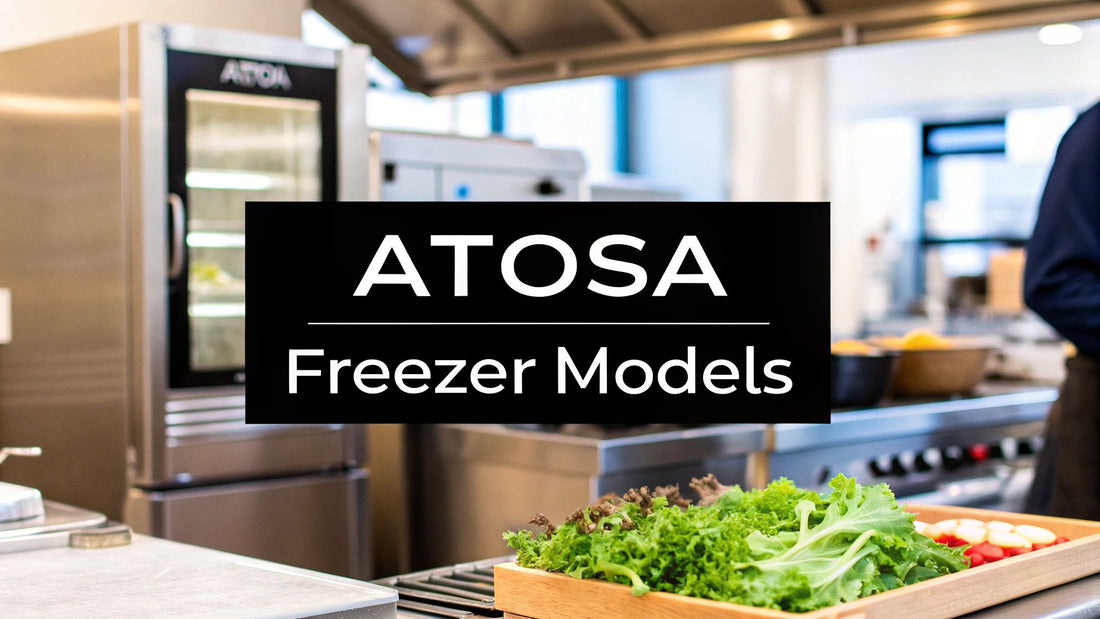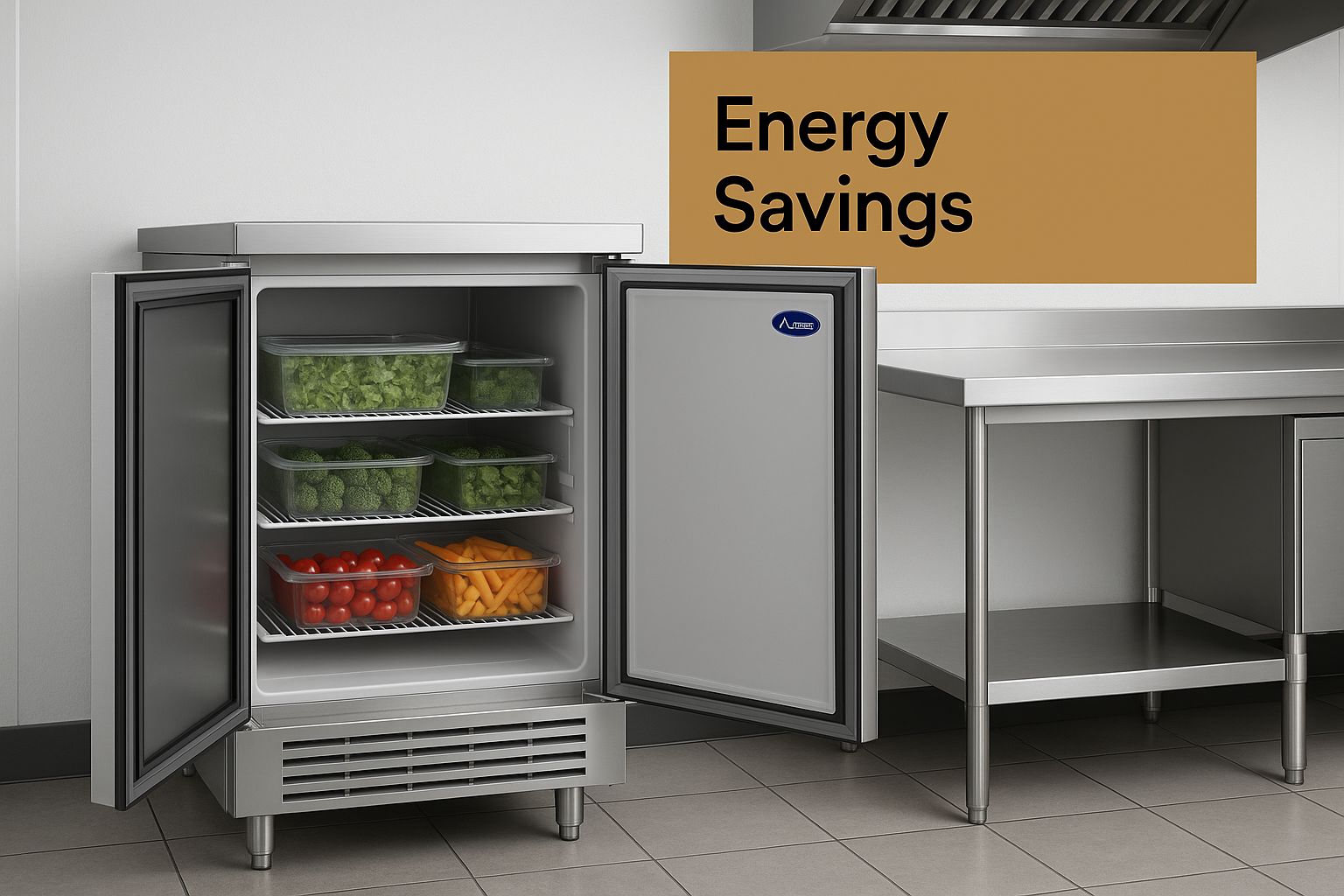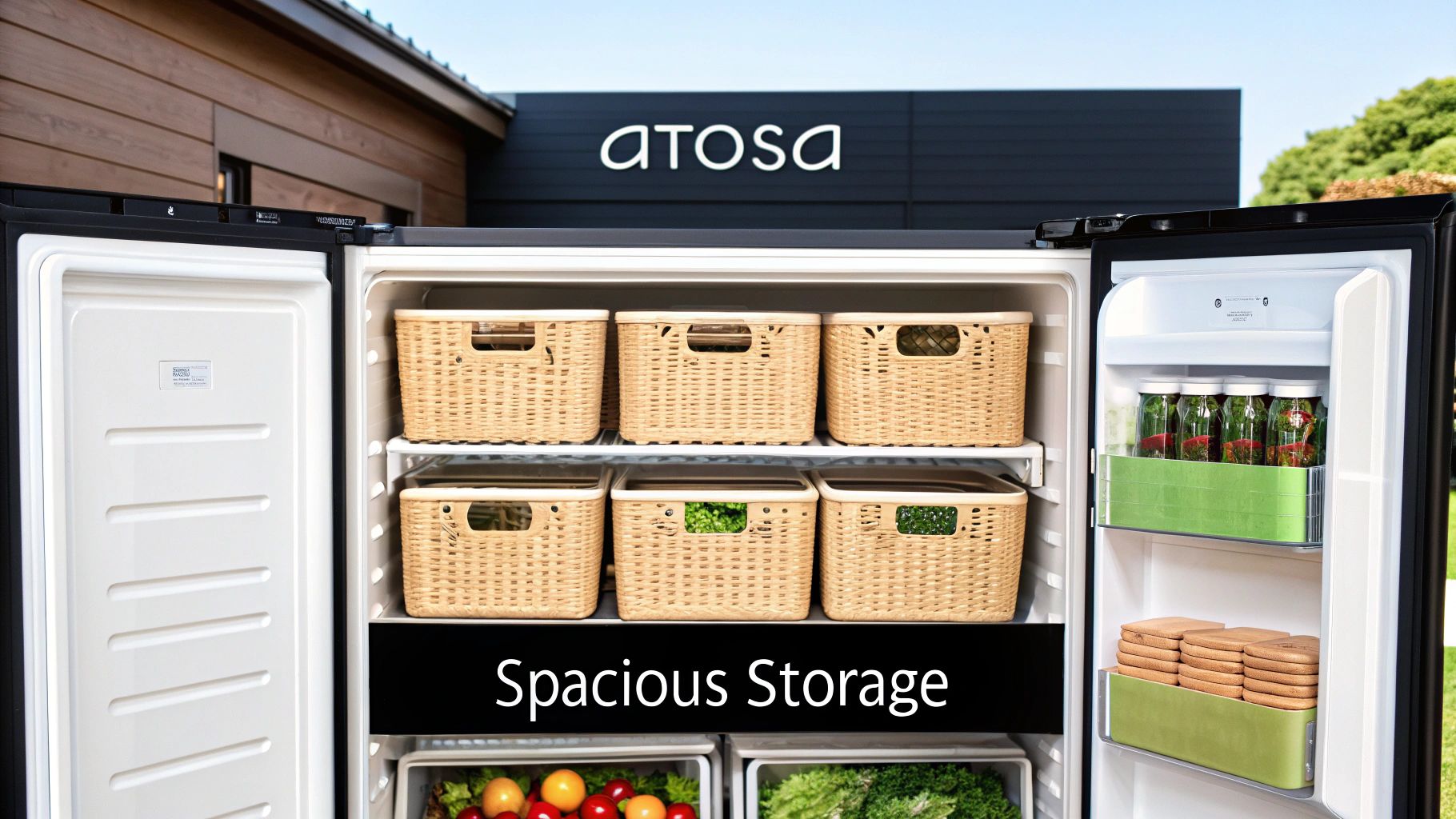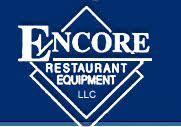
The Ultimate Guide to Atosa Freezer Models
Share
When you're running a commercial kitchen, every piece of equipment you buy is a big decision. It's not just another expense on a spreadsheet; it's a strategic move. Choosing an Atosa freezer is a prime example of a smart investment, giving you the durability you need for the daily grind without breaking the bank. This guide is designed to help restaurant owners and chefs stay informed about industry trends and discover how the right equipment can impact their business, starting with reliable cold storage.
Why an Atosa Freezer Is a Smart Kitchen Investment
If you're a seasoned chef or a sharp restaurant owner, you know your equipment has to be a workhorse. Opting for an Atosa freezer isn't just buying a box that chills; it's a direct contribution to your bottom line.
This is especially true when you look at the bigger picture. The worldwide market for commercial refrigeration is booming, a key industry trend for any food service professional. In fact, the reach-in freezer segment alone was valued at USD 24.64 billion in 2024 and is expected to climb even higher. This tells you one thing: reliable and efficient cold storage is a massive priority for the entire industry. For a deep dive into these trends, you can find more insights on the reach-in freezer market's future on ResearchAndMarkets.com.
More Than Just Cold Storage
Think of a top-notch freezer as an insurance policy for your food costs. How much profit have you seen evaporate because a cheap unit couldn't hold its temperature? Atosa built its name on preventing exactly that, offering solid construction and performance you can count on.
When your equipment just works, it frees you up to do what you do best: cook. Instead of stressing about whether your freezer is on the fritz, you can confidently buy ingredients in bulk, manage your stock with precision, and slash food waste.
The right freezer does more than just preserve ingredients—it enhances kitchen workflow, protects food costs, and contributes directly to your restaurant's profitability.
Built for the Real World of a Commercial Kitchen
Atosa gets it. They know a restaurant kitchen is a battlefield. That's why their freezers are designed to handle the chaos.
- Durability: They're built with heavy-duty stainless steel. That means they can take the bumps, dings, and spills that are just part of a busy service.
- Efficiency: Atosa uses modern, energy-saving parts. This directly translates to lower utility bills, which is a huge win for managing your overhead.
- Value: This is where Atosa really shines. They deliver a fantastic mix of performance and affordability, putting quality equipment within reach for everyone, from brand-new ventures to established restaurants.
At the end of the day, putting your money into an Atosa freezer is really an investment in the long-term health and stability of your business.
Navigating the Atosa Freezer Lineup
Picking the right commercial freezer can feel overwhelming, but Atosa keeps things straightforward with a lineup where every model has a clear purpose. Let's walk through the main options to figure out which one makes the most sense for your kitchen's specific needs, space, and daily grind.
Think of it like setting up your cook line—you wouldn't put a deep fryer where your garde manger station should be. The same logic applies here. You need to match the freezer's design to the job it's going to do, day in and day out.
For your main storage, the MMF reach-in series is the workhorse. These are your kitchen's food bank, designed to hold bulk inventory and keep it organized. They’re the foundation of a solid cold storage system, perfect for back-of-house areas where you just need to store as much product as possible.

As you can see, a modern, well-designed freezer doesn't just store food; its efficiency features directly impact your energy bills, saving you money over the long haul.
Finding the Right Fit for Your Workflow
Now, let's talk about the units designed for the heat of service. This is where undercounter and worktop freezers become essential.
Take the MCF undercounter series, for instance. I like to call these the "express lanes" for your line cooks. They tuck right under a prep counter, putting frozen items like fries, appetizers, or proteins within arm's reach. This simple placement eliminates those constant trips to the walk-in, which can shave precious seconds off ticket times during a chaotic dinner rush.
The core idea is simple: match the unit to the task. A big reach-in is for your inventory stock. An undercounter freezer is for the high-turnover ingredients you need right now.
Worktop freezers take this a step further by combining cold storage with a functional prep surface. These are brilliant for tight kitchens or dedicated stations, like a dessert or sandwich prep area, where every inch of space counts. They pull double duty, streamlining the workflow without expanding your footprint. If you're looking for that kind of multi-tasking power, you can learn more about the benefits of an Atosa AT102 Worktop Freezer and see how it might fit into your kitchen.
To help you visualize where each model excels, here’s a quick comparison.
Atosa Freezer Models at a Glance
This table breaks down the primary Atosa freezer types to help you quickly identify the best match for your kitchen's unique demands.
| Freezer Type | Primary Use Case | Best For | Key Feature |
|---|---|---|---|
| Reach-In Freezer | Bulk inventory storage | Back-of-house, main storage areas | Maximum capacity and organization |
| Undercounter Freezer | Point-of-use storage | Busy cook lines, prep stations | Quick access to high-turnover items |
| Worktop Freezer | Combined storage & prep | Small kitchens, specific stations | Dual-functionality (storage + workspace) |
| Glass Door Freezer | Display & quick inventory | Front-of-house, quick-grab areas | Visual access without opening the door |
Ultimately, understanding these core models helps you make a more informed choice that supports your team and your bottom line.
Glass Doors Versus Solid Doors
One last decision you'll face is choosing between glass and solid doors. It seems minor, but it affects daily operations.
Glass door models are fantastic for front-of-house displays or for allowing staff to see what’s inside at a glance. This quick visual check means the door stays closed more often, which helps keep the internal temperature stable.
On the flip side, solid door freezers typically provide superior insulation. This can translate to better energy efficiency and slightly lower utility costs over time. The choice really boils down to what you value more: the convenience of a quick visual inventory or squeezing every bit of efficiency out of your equipment.
The Features That Drive Performance and Efficiency

So, what makes an Atosa freezer a trusted workhorse in a high-pressure kitchen? It all comes down to the smart engineering choices that have a real, tangible impact on your day-to-day operations and, just as importantly, your bottom line. These units are built from the ground up to take the constant abuse of a professional food service environment.
The first thing you’ll probably notice is the heavy-duty stainless steel construction. This isn't just for show. Think of it as armor, protecting your freezer from the daily grind of dings, spills, and the general chaos of a busy service. This durability means your investment is built to last for years.
Smart Design for a Smarter Kitchen
Atosa has a knack for integrating features that are both incredibly practical and efficient. For instance, many of their models come with a bottom-mounted compressor, a design detail that offers a surprising number of benefits for your staff and your budget.
By placing the compressor at the bottom, the lowest shelf is raised higher off the ground. This might seem like a small thing, but it means less bending and straining for your crew during a hectic shift. Even better, the compressor is positioned in the coolest part of the kitchen—down near the floor. It doesn't have to fight against rising heat, so it runs more efficiently, consuming less energy and suffering less wear and tear over time.
Another standout feature is the Dixell digital temperature control system. This gives you pinpoint, reliable command over your freezer’s internal climate.
With Dixell controls, you can essentially set it and forget it. You get peace of mind knowing your expensive inventory is safe from the temperature swings that lead to spoilage and wasted money. This precision is your best defense for food safety and cost control.
Having this level of control is non-negotiable in a well-run kitchen. In fact, reliable equipment is the foundation of any successful operation, which is why any good commercial kitchen equipment checklist will always put quality refrigeration right at the top of the list.
Efficiency That Impacts Your Bottom Line
Atosa’s focus on efficiency is about more than just where they put the compressor. Their freezers are packed with clever, energy-saving features that translate into real savings on your utility bills.
- Self-Closing Doors: We’ve all seen it—a door left slightly ajar, bleeding cold air and energy. Atosa’s self-closing doors swing shut on their own, stopping cold air from escaping and preventing the compressor from running constantly to catch up.
- Magnetic Door Gaskets: A perfect seal is crucial. These heavy-duty gaskets clamp the door shut, creating an airtight barrier that keeps the cold in and the warm kitchen air out. It's a simple but vital part of maintaining consistent temperatures.
- Eco-Friendly Refrigerant: Many Atosa freezers use R290 hydrocarbon refrigerant. This is a big deal. It has an extremely low Global Warming Potential (GWP) and is significantly more energy-efficient than the older refrigerants it replaces.
This commitment to green technology isn't just about helping the planet; it directly cuts down your monthly operating costs. When you combine tough-as-nails construction with thoughtful, efficient engineering, an Atosa freezer stops being just another appliance. It becomes a strategic tool for building a more profitable and resilient business.
How to Choose the Perfect Atosa Freezer Size
Choosing the right Atosa freezer isn’t just about finding an empty spot in your kitchen; it’s a strategic decision that affects your entire operation. A freezer that’s too big will just sit there, hogging expensive floor space and racking up your energy bill. Go too small, and you’ll constantly be fighting for space, which can bring your kitchen’s workflow to a grinding halt. The goal is to find a unit that’s an asset, not an obstacle.
The process starts with the most fundamental step: measuring your space. Grab a tape measure and get the real-world numbers—the exact width, depth, and height you have to work with. Don't forget to add a few inches of clearance on all sides for ventilation. That breathing room is non-negotiable for keeping the freezer running efficiently and preventing it from overheating.
Assess Your Menu and Volume Needs
Once you know the physical footprint you're working with, it’s time to look at your inventory. The amount and type of food you need to keep frozen will ultimately determine the capacity you need.
To get a clear picture, ask yourself a few practical questions:
- How much frozen product do we go through daily? A bustling kitchen that's constantly pulling and restocking frozen goods needs different storage than a spot that just keeps bulk items frozen for weeks at a time.
- What are we actually storing? Are you freezing big, awkward boxes of french fries, or are you storing neatly stacked hotel pans of prepped sauces? The shape of your inventory dramatically changes how you can use the freezer's internal space.
- How often do our suppliers deliver? If you get several small drops a week, you might get by with a smaller unit. But if you’re buying in bulk to lock in better pricing, you’ll need a lot more cubic footage to handle those large orders.
Thinking through these points helps you look past the spec sheet and focus on what your kitchen actually needs to run smoothly.
A common mistake is buying for today without thinking about tomorrow. Always factor in your plans for growth. A slightly larger freezer now can save you from a massive headache—and a big expense—down the road.
Solid Doors Versus Glass Doors
Your final major decision point is between solid and glass doors, and this choice has a direct impact on both your energy costs and your daily workflow.
Solid doors are the undisputed kings of insulation. They are simply better at keeping the cold air where it belongs—inside the freezer. This superior thermal efficiency almost always leads to lower energy consumption over the life of the unit, which is a win for your bottom line.
Glass doors, on the other hand, offer the huge advantage of visibility. Your staff can see exactly what's inside and find what they need without ever opening the door. This keeps the internal temperature stable and saves precious seconds during a chaotic dinner rush. In a fast-paced kitchen, that kind of convenience can be a game-changer.
The demand for efficient commercial refrigeration, especially for compact units like the undercounter models Atosa excels at, is an important industry trend. As the food service industry continues to expand, so does its reliance on frozen goods. The market for commercial undercounter freezers alone was valued at USD 1.2 billion in 2024 and is projected to grow significantly. This growth is fueled by our increasing appetite for frozen foods and the boom in food delivery services.
This trend highlights just how important it is to choose energy-efficient appliances to keep operating costs in check. You can discover more about the growing commercial freezer market on VerifiedMarketReports.com. By carefully weighing your kitchen's physical space, inventory needs, and door preferences, you'll be well-equipped to select the perfect Atosa freezer for your business.
Protecting Your Investment with Essential Maintenance
Think of your Atosa freezer as one of the hardest-working members of your kitchen staff. It's on 24/7, silently protecting thousands of dollars worth of inventory. Just like any key player, it needs a little routine care to perform at its best. This isn't about becoming a refrigeration technician overnight; it's about simple, consistent habits that prevent costly breakdowns and keep your food safe.
A few minutes of preventative care each day or week can save you from the gut-wrenching experience of a freezer failure during a packed dinner service. By building a simple maintenance routine, you’re not just cleaning—you’re extending the life of your equipment, keeping energy bills down, and avoiding those frantic calls for emergency repairs.
Your Actionable Maintenance Checklist
Consistency is everything. A simple checklist that your team can follow is the secret to a long-lived, efficient Atosa freezer. Here’s a practical plan you can put into action today.
Daily Tasks (Takes Less Than 5 Minutes):
- Glance at the Temperature: A quick look at the digital display confirms everything is holding steady. This is your first and fastest check against potential food spoilage.
- Wipe the Door Gaskets: Use a clean, damp cloth to wipe down the rubber seals around the door. Crumbs and grime can prevent a tight seal, making your freezer work harder than it needs to.
Weekly Tasks (Takes 10-15 Minutes):
- Deep Clean the Gaskets: Go beyond a simple wipe-down. Inspect the gaskets for any rips, cracks, or brittleness. A leaky gasket is one of the biggest energy vampires in a commercial kitchen.
- Clean Interior and Exterior: Give the whole unit a proper cleaning with a food-safe solution. This isn’t just for looks; a clean freezer is a more efficient freezer, and it's essential for meeting health codes.
The "why" here is simple: a clean, well-sealed freezer doesn't have to fight to stay cold. Think of clean condenser coils as clear airways for your freezer's cooling system. When they aren't clogged with dust and grease, the compressor doesn't have to strain, which directly translates to lower energy bills.
Troubleshooting Common Issues
Before you pick up the phone to call a technician, a few quick checks can often solve the problem and save you a service fee. Here’s what to look for when you run into common hiccups:
- The Freezer Isn't Cold Enough: First, the obvious: is the door shut completely? If so, take a closer look at the door gaskets. Gaps or damage are the usual suspects for air leaks.
- The Unit is Running Constantly: This almost always points to dirty condenser coils. These coils, usually found at the bottom or back of the unit, are designed to release heat. When they get caked in dust and kitchen grease, the freezer can't get rid of heat effectively, forcing the compressor to run nonstop to keep up.
- Frost is Building Up Inside: A heavy frost buildup is a classic sign of an air leak. The door gasket is the place to check. Try the dollar bill trick: close the door on a bill. If you can pull it out with zero resistance, your gasket isn't sealing tight and likely needs to be replaced.
Why an Atosa Freezer is a Smart Move for Any Modern Kitchen

When you're outfitting a commercial kitchen, choosing a freezer isn't just about finding a cold box. It's a serious business decision, one that ripples through your daily operations, affecting everything from food costs to staff morale. Picking an Atosa freezer is a strategic play that pays off by creating a more resilient, efficient, and profitable kitchen.
Think of reliable refrigeration as your front-line defense against food spoilage. Every bit of product that goes bad is a direct hit to your bottom line. An Atosa unit delivers the kind of steady, dependable temperature control that protects your inventory. This gives you peace of mind and the flexibility to buy ingredients in bulk when the price is right.
Streamline Your Kitchen and Boost Your Profits
The right freezer does more than just keep food cold; it makes your entire team more effective. An intelligently designed Atosa freezer, placed thoughtfully within your kitchen's flow, cuts down on wasted movement during a chaotic dinner rush. That means faster ticket times, a smoother service, and a much happier crew.
On top of that, Atosa’s focus on energy efficiency helps build a more sustainable and profitable business. Their modern compressors and eco-friendly refrigerants aren't just a nod to the environment—they actively reduce your monthly utility bills. That’s cash freed up to reinvest elsewhere in your restaurant.
In the tough world of food service, dependable equipment isn't a luxury; it's a necessity. Investing in a solid freezer like an Atosa is fundamental. You're not just buying cold storage; you're making a smart business investment.
A Worthwhile Investment in a Growing Industry
This push for efficiency and reliability isn't just a trend; it's a major shift across the industry. The demand for better commercial refrigeration is booming as restaurant owners seek smarter storage. This is especially true for equipment that makes the most of limited space, like undercounter and worktop models. As the food service industry grows, the need for reliable, efficient refrigeration only becomes more critical. You can learn more about commercial refrigeration market trends from Future Market Insights to see where things are headed.
At the end of the day, an Atosa freezer is far more than just an appliance. It's a tool that protects your inventory, empowers your team, and directly supports your financial health. It’s a cornerstone for any kitchen that’s serious about long-term success.
Frequently Asked Questions About Atosa Freezers
When you're looking into commercial freezers, a lot of specific questions can pop up. Let's walk through some of the most common things restaurant owners and chefs ask about Atosa units. Getting these answers straight helps you make a choice you can feel good about.
What Is the Warranty on a Typical Atosa Freezer?
Atosa backs its equipment with a really solid warranty. You'll typically find a multi-year parts and labor warranty right out of the box. On top of that, they usually offer an extended warranty just for the compressor—the real workhorse of the unit.
Of course, it's always smart to double-check the specific terms for the model you have your eye on, as the details can sometimes differ. This kind of strong warranty is a great sign that Atosa is confident their freezers can handle the daily grind of a professional kitchen.
How Do Atosa Freezers Compare to Other Major Brands?
This is a great question. Atosa has carved out a fantastic spot in the market by balancing quality, dependable performance, and affordability. While some big-name brands might come with more bells and whistles (and a much higher price tag), Atosa is known for building tough, efficient freezers that get the job done.
They offer tremendous value, making them a go-to choice for new restaurants on a budget and established kitchens looking for a smart equipment upgrade.
Atosa's real strength is its focus on the essential, heavy-duty features that truly matter in a kitchen. You're investing in performance and reliability, not just flashy extras you might never use.
For more answers to common equipment questions, you might want to check out our full list of frequently asked questions, where we cover a wide range of topics.
Where Can I Find Service for My Atosa Freezer?
Finding service is straightforward. Atosa has a wide network of authorized service technicians and parts distributors ready to help.
Your best first step is usually to call the dealer you bought the unit from. If that’s not an option, you can always head to the official Atosa website to find a certified service pro near you. To make things go smoothly, have your freezer's model and serial number handy when you call—it will speed up everything from scheduling service to ordering the right parts.
Ready to invest in a freezer that's both reliable and efficient? Explore our full selection of Atosa freezers at Encore Seattle Restaurant Equipment and find the perfect fit for your kitchen today. Visit us at https://encoreseattle.com to discover our latest deals on restaurant equipment and supplies.
